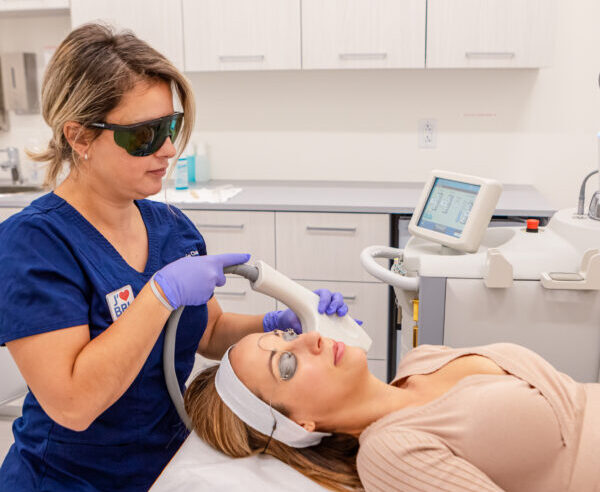SUBSCRIBE TO OUR NEWSLETTER & RECEIVE $25 OFF* LEARN MORE
Platysma Bands
Platysma bands are the vertical lines or cords that can become more visible on the neck over time, especially when the muscles contract during speech or facial movement. As the skin loses elasticity and underlying muscle tone becomes more pronounced, these bands may begin to subtly alter the contours of the jawline and neck. For some, they appear gradually with age, while for others they are visible earlier due to genetics or natural facial anatomy.
Though completely normal, their appearance can sometimes create a sense of tension or heaviness in the neck area and may contrast with how youthful or vibrant you feel on the inside. This concern is not about erasing time but rather about restoring balance, smoothness, and ease to an area that is often central to expression and grace.
Non-invasive treatments can help soften the appearance of platysma bands by gently relaxing targeted muscles and supporting the surrounding skin. With a refined and personalized approach, it is possible to restore harmony to the neck and lower face so your profile reflects your inner poise and vitality.
Natural Muscle Activity
The platysma muscle runs from the jawline down to the collarbones and plays a role in facial expression and neck movement. Over time, repeated use causes this thin, sheet-like muscle to become more prominent, particularly when speaking, smiling, or clenching the jaw.
Aging and Skin Laxity
With age, the skin becomes thinner and loses collagen and elastin, making the platysma bands beneath the surface more visible. As the muscle separates into distinct vertical bands and the skin becomes looser, these lines can appear even when the neck is at rest.
Loss of Jawline Definition
When the jawline begins to soften due to volume loss and gravity, it can accentuate the appearance of the platysma bands. This is often part of a broader pattern of lower face aging, which may also include jowls or a sagging chin.
Genetics and Facial Anatomy
Some people are naturally more predisposed to prominent neck bands due to their muscle structure, skin type, or genetic aging patterns. These bands can appear earlier or more noticeably in lean individuals with strong platysma activity.
Tension and Clenching
Like other facial muscles, the platysma can become overactive from chronic stress, jaw clenching, or poor posture. This can exaggerate the vertical pulling effect on the neck, particularly when combined with thinning skin.
At Victoria Park Medispa, we offer gentle, non surgical options such as neuromodulator injections to relax the platysma muscle and soften visible neck bands. With precision and care, our medical team will help restore a more graceful and refreshed neckline in a way that feels natural to you.
Platysma Bands
Solutions

Neuromodulators
Neuromodulators relax the platysma muscle to soften vertical neck bands and create a smoother, more refined neckline.
Who it’s for: Individuals with visible platysma bands that appear when speaking, smiling, or straining, and who are seeking a non-surgical solution.
Treatment plan: A single session, with results typically lasting 3 to 4 months; maintenance sessions can be scheduled as needed.
Results: A smoother, softer neckline with reduced visibility of platysma bands, with improvements usually seen within 5 to 7 days and full effect in about 2 weeks.

Skin booster Injections
Skin booster injections, such as Skinvive™, are administered in microdroplets to hydrate and smooth the skin. They help soften horizontal neck lines without adding volume.
Who it’s for: Fine to moderate lines caused by aging, movement, or “tech neck,” for those seeking a subtle and natural result.
Treatment plan: A single session, with results lasting about 6 months; maintenance as needed.
Results: Smoother, more hydrated skin with softened lines visible within a few weeks.

Ultherapy®
Ultherapy® uses ultrasound energy to stimulate collagen, firming and lifting the skin around the neck and jawline.
Who it’s for: Mild to moderate skin laxity contributing to neck bands, preferring a gradual, non-invasive treatment.
Treatment plan: Single session, with results developing over 2 to 3 months and lasting up to a year.
Results: Firmer, tighter neck with improved contour and reduced sagging over time.

Not sure which treatment is right for you ?
Schedule a complimentary consultation with our experts to discuss your needs
WHY CHOOSE
VICTORIA PARK MEDISPA
-
Financing
Our partnership with Beautifi means our patients can get the treatments they deserve with low-interest, flexible monthly payments.
-
Price match policy
If you discover a better price on laser-based aesthetic services, let us know, and we’ll match that figure.*Details apply.
-
Access to the best experts
Our medical team is made up of the country’s top board-certified plastic surgeons and dermatologists. These experts are supported by a team of dedicated registered nurses who are passionate about helping you achieve your aspirations.
FAQ
Got questions about platysma bands? We’ve got answers!
Neuromodulators are commonly used to soften the appearance of platysmal bands by relaxing the muscle responsible for their tension. This helps smooth the contour of the neck and jawline. For more advanced concerns, treatments such as Morpheus8 or Ultherapy can be combined to further tighten the area.
Most treatments require between 20 and 30 units, distributed across several small injection points along the neck. The dosage is always personalized according to the severity and distribution of the bands.
Neuromodulators relax the platysma muscle, which reduces the downward pull that causes vertical cords. As a result, the neck appears smoother and more rejuvenated.
Discomfort is minimal. Most patients describe the injections as quick pinches. A numbing cream can be applied for additional comfort, though it is rarely necessary.
An initial softening is usually visible within 5 to 7 days, with full results appearing around two weeks. The effect typically lasts between 3 and 4 months.
Yes, to a certain extent. By relaxing the muscles that pull downward, neuromodulators can create a subtle lifting effect. For more significant skin laxity, they are often combined with treatments such as Morpheus8, Ultherapy, or skin boosters, which stimulate collagen and improve skin firmness.
No. Some people never develop them, while others may notice them as early as their thirties or forties. Genetic factors, muscle activity, and skin quality all influence their appearance.
Neuromodulators can significantly reduce the appearance of platysmal bands, but they do not eliminate the underlying muscle. Regular treatments are needed to maintain results.
No. While neuromodulators are effective for relaxing the muscle, they can be combined with skin-tightening treatments such as Morpheus8, Ultherapy, or skin boosters to further enhance skin tone and texture.
Yes. When performed by a qualified healthcare professional, this treatment is safe and carries very minimal risk of side effects. It does not require any downtime.
In most cases, no. Neuromodulator injections target only the superficial platysma muscle and do not interfere with the deeper muscles responsible for speech, swallowing, or neck movement.
Recent
articles
Request an appointment
Let's get in touch
Not ready to book your consultation yet? Contact us by filling in the form below or call us at 514.488.8668 to discuss your questions with a member of our Appointment Concierge Team. We look forward to helping you.


